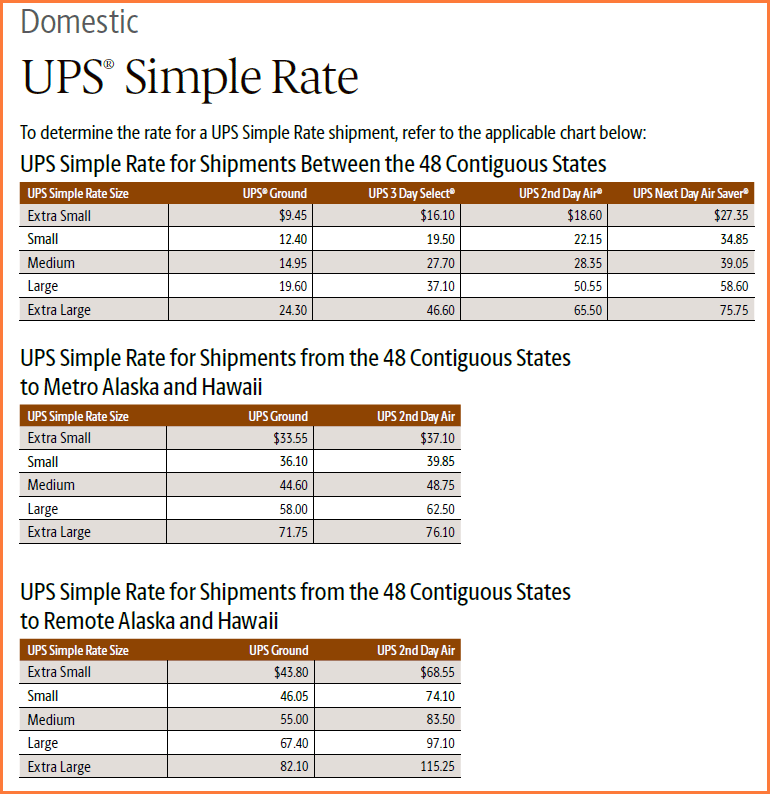When it comes to shipping packages, UPS stands out as one of the most reliable carriers in the industry. But how do you navigate the complexities of UPS shipping rates? Shipping rates can vary significantly based on various factors, including package size, weight, delivery speed, and destination. For businesses and individuals alike, understanding these rates is crucial for budgeting and planning purposes. In this article, we will delve into the intricacies of UPS shipping rates, helping you make informed decisions for your shipping needs.
Whether you’re a small business owner looking to ship products to your customers or someone sending a gift across the country, knowing the ins and outs of UPS shipping rates can save you time and money. With this guide, you will learn how to calculate shipping costs, what factors influence these rates, and how you can optimize your shipping strategy. Let’s embark on this journey to demystify UPS shipping rates and ensure your packages reach their destinations efficiently and affordably.
From understanding the different service options available to knowing how to track your packages, our goal is to equip you with the essential knowledge needed to navigate the world of shipping. So, whether you are a seasoned shipper or a first-timer, join us as we explore the various facets of UPS shipping rates.
What Are UPS Shipping Rates and How Are They Determined?
UPS shipping rates are the fees charged by UPS to transport packages from one location to another. These rates are determined by several factors, which include:
- Package Weight: Heavier packages typically incur higher shipping fees.
- Package Dimensions: The size of the package can affect the shipping rate, especially for oversized items.
- Delivery Speed: Faster delivery options, such as next-day air, come with a premium cost.
- Shipping Distance: Longer distances generally result in higher shipping rates.
- Service Type: Different service levels (ground, air, international) have distinct pricing structures.
How Can You Calculate UPS Shipping Rates?
Calculating UPS shipping rates requires understanding the aforementioned factors. Here’s a step-by-step guide to help you:
- Measure Your Package: Determine the weight and dimensions of your package.
- Choose Your Shipping Service: Decide on the delivery speed that best suits your needs.
- Use the UPS Rate Calculator: Visit the UPS website and use their online rate calculator to get an estimate.
- Consider Additional Services: Add any extra services such as insurance or signature confirmation, which may affect the overall cost.
What Are the Different UPS Shipping Services Available?
UPS offers a variety of shipping services tailored to meet different needs:
- UPS Ground: Reliable delivery service for packages within the U.S. with varying transit times.
- UPS Next Day Air: Fastest shipping option for urgent packages, with delivery by the next morning.
- UPS 2nd Day Air: Cost-effective option for deliveries required within two days.
- UPS International Services: Solutions for shipping packages internationally, including customs clearance support.
How Do UPS Shipping Rates Compare to Other Carriers?
When evaluating shipping options, it’s essential to compare UPS shipping rates with those of other carriers such as FedEx and the United States Postal Service (USPS). Each carrier has its strengths and weaknesses, which can influence overall costs.
What Factors Should You Consider When Choosing a Shipping Carrier?
When determining which shipping carrier to use, consider the following factors:
- Cost: Compare shipping rates to find the best deal for your budget.
- Delivery Speed: Assess how quickly you need your package to arrive.
- Reliability: Research the carrier's track record for on-time deliveries.
- Customer Service: Consider the level of support offered by each carrier in case issues arise.
Can You Negotiate UPS Shipping Rates?
Yes, it is often possible to negotiate UPS shipping rates, especially for businesses that ship large volumes. Here’s how:
- Analyze Your Shipping Needs: Gather data on your shipping volume and frequency.
- Contact UPS: Reach out to a UPS representative to discuss potential discounts.
- Be Prepared to Commit: Carriers may offer better rates in exchange for a long-term shipping agreement.
What Are the Benefits of Using UPS for Your Shipping Needs?
Utilizing UPS for your shipping needs offers several advantages:
- Wide Range of Services: UPS provides various shipping options to cater to different requirements.
- Global Reach: UPS has extensive international shipping capabilities.
- Advanced Tracking: UPS offers robust tracking tools to monitor your shipments in real-time.
- Reliable Delivery: UPS has a strong reputation for timely deliveries and package safety.
How to Optimize Your Shipping Strategy with UPS?
To optimize your shipping strategy with UPS, consider the following tips:
- Utilize Shipping Software: Invest in software that integrates with UPS for streamlined shipping processes.
- Consolidate Shipments: Combine multiple packages into one shipment to save on costs.
- Regularly Review Shipping Rates: Stay updated on changes in shipping rates and adjust your strategy accordingly.
- Take Advantage of Discounts: Explore any available discounts or loyalty programs offered by UPS.
Conclusion: Understanding UPS Shipping Rates for Better Decision-Making
In conclusion, understanding UPS shipping rates is essential for anyone looking to ship packages efficiently and cost-effectively. By considering the various factors that influence rates, comparing UPS with other carriers, and optimizing your shipping strategy, you can make informed choices that benefit your personal or business shipping needs. Whether you are sending a birthday gift or managing a product shipment for your business, being knowledgeable about UPS shipping rates will empower you to navigate the shipping landscape with confidence.




